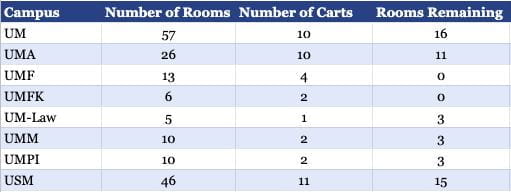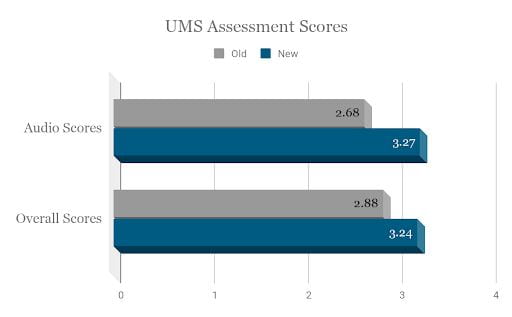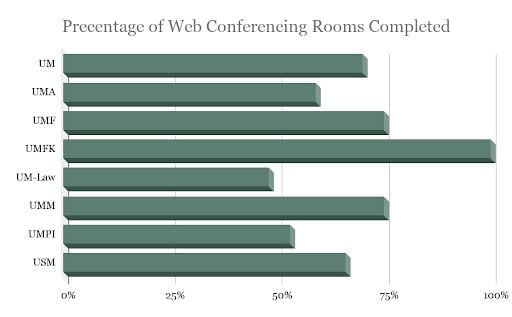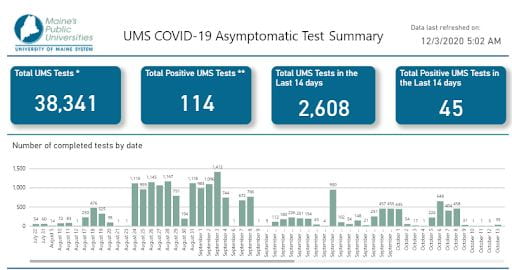 As the University of Maine System prepared for the Fall 2020 Safe Return to campuses, the US:IT team was hard at work to prepare for the demand and ensure access to robust, reliable tools to support instruction, both in the classroom and online. These efforts included the creation of the Welcome to Campus 2020: IT Resources and Tools page to serve as a resource guide for informing members of the UMS Community on services and options to complete remote work, teaching, and learning.
As the University of Maine System prepared for the Fall 2020 Safe Return to campuses, the US:IT team was hard at work to prepare for the demand and ensure access to robust, reliable tools to support instruction, both in the classroom and online. These efforts included the creation of the Welcome to Campus 2020: IT Resources and Tools page to serve as a resource guide for informing members of the UMS Community on services and options to complete remote work, teaching, and learning.
To further support classroom instruction, the US:IT team worked quickly and efficiently to install web conferencing equipment in several UMS classrooms during Summer 2020, allowing students to join classes remotely as needed. The team also set up the #CampusClear application to help monitor symptoms relating to COVID-19 and developed the COVID-19 data mart to support Asymptomatic Testing. Details on these initiatives and other Fall 2020 updates are provided below.
COVID-19 WEB CONFERENCING CLASSROOM UPGRADES | COURSE DELIVERY | #CAMPUS CLEAR | ASYMPTOMATIC TESTING | INFO SEC OFFICE ACTIVITY IN RESPONSE TO PHISHING | CARD SERVICES
COVID-19 WEB CONFERENCING CLASSROOM UPGRADES
In response to the global COVID-19 pandemic, the Board of Trustees approved a $2.56 million dollar investment in web conferencing technology for classrooms. The project’s intent was to increase the number of learning spaces capable of web conferencing and video lecture capturing throughout the University of Maine System. The new equipment provided faculty and students with scheduling and location flexibility, either in-person or online, to accommodate their needs and social distancing protocols due to the pandemic.
The Classrooms for the Future (CFTF) team consisting of members from UMS IT Classroom Technology, Media and Support Services, End-User Technology and Project Management executed 124 classroom upgrades and built 42 web  conferencing carts during the months of June, July and August. The classroom installations were completed in a rapid timeframe to meet the start of the Fall semester. Planning, purchasing equipment, installation and programming, testing, documentation and training were all completed in a three month time period. The team faced challenges of limited supplies due to the increased international demand for equipment, shipping delays as the ripple effect of the pandemic slowed items clearing customs, and shifting room designations as seating capacities were determined by social distancing protocols.
conferencing carts during the months of June, July and August. The classroom installations were completed in a rapid timeframe to meet the start of the Fall semester. Planning, purchasing equipment, installation and programming, testing, documentation and training were all completed in a three month time period. The team faced challenges of limited supplies due to the increased international demand for equipment, shipping delays as the ripple effect of the pandemic slowed items clearing customs, and shifting room designations as seating capacities were determined by social distancing protocols.
The classrooms were chosen through a criteria of seating capacity based on COVID-19 restrictions, campus scheduling needs and existing classroom technology systems that were upgraded in the last several years through CFTF funds. Focusing on rooms that had received upgrades within the last three years ensured that existing classroom technology was compatible with new web conferencing equipment being installed. Additionally, by installing in rooms that had been previously upgraded through CFTF, the team avoided facility work needing to be completed prior to installation such as asbestos removal.. Facility work can be time consuming and potentially pose a risk to the timeline.
All rooms that were completed during the Summer have been reassessed. The upgrades improved the overall average score for web conferencing classrooms throughout the UMS. The score is based on a 1-4 rating of 43 discrete characteristics across 6 categories: Functionality, Finishing, Environment, Displays & Cameras, Audio and Accessibility. Prior to the summer work the overall score was 2.88 while the new score is 3.24. The highest improvements were in the audio scores which are particularly pertinent to web conferencing installations. The Audio score went from 2.88 to 3.24. The scores are based on  audio from the room to remote participants and playback audio in the room from any computer or media devices connected to the system. Displays & Cameras, another score that would be impacted by web conferencing improvements, remained relatively even in its scoring. A factor in the equal scoring is the age of the displays. The scores of the displays for earlier installations were a point lower because of age.
audio from the room to remote participants and playback audio in the room from any computer or media devices connected to the system. Displays & Cameras, another score that would be impacted by web conferencing improvements, remained relatively even in its scoring. A factor in the equal scoring is the age of the displays. The scores of the displays for earlier installations were a point lower because of age.
The CFTF team elicited and collected feedback from faculty, students and installers during the Fall semester. The team has made adjustments to the  Winter projects and will be adding some technology to a few of the Summer projects based on that feedback. Overall, the systems have been well received by the campuses, faculty and students. The upgrades accomplished the goals set out for the project; allowing students and faculty to have
Winter projects and will be adding some technology to a few of the Summer projects based on that feedback. Overall, the systems have been well received by the campuses, faculty and students. The upgrades accomplished the goals set out for the project; allowing students and faculty to have ![]() flexibility for in-person and online courses both synchronously and asynchronously.
flexibility for in-person and online courses both synchronously and asynchronously.
In preparation for Winter Break installations and another tight timeline, project team members completed some of the installation prep work in the rooms during the summer and fall months. The remaining 57 classrooms will receive the same equipment as those completed in the Summer with minor adjustments based on feedback from faculty and students. The Media Services team is coordinating with the campuses and moving the web conferencing carts based on the campuses’ needs for the Spring semester.
Finally, the team will once again provide in person orientations and training sessions for faculty during the weeks prior to and into the start of Spring semester. The team has also made available the on-line training video created in the Summer.
COURSE DELIVERY IN FALL 2020

Brightspace was successfully launched as the primary Learning Management System (LMS) for UMS in Fall 2020, replacing Blackboard Learn. All UMS courses available in the MaineStreet Student Information System have an associated course shell provisioned in the Brightspace LMS. Student enrollments are synchronized between Brightspace and MaineStreet every 20 minutes. More details on the implementation of Brightspace can be found on the project website.

Zoom usage over 2020 increased drastically, with web conferencing becoming increasingly critical to how we teach, learn, and work. The Fall 2020 Semester has seen roughly 130,000 meetings per month, with most days seeing at least 5000 meetings scheduled. September and October have both crossed the threshold for one million meeting minutes per month.
Over the course of the year, Zoom has invested its resources in expanding capacity and improving security, and US:IT has similarly invested in our ability to provide the support needed for teaching, learning, and working remotely.
![]()
Kaltura also has seen a significant increase in usage since March 2020, with the vendor reporting a 1000% increase in activity. This drastic change, unfortunately, had impacts on the performance of the platform. The unprecedented growth drove Kaltura to expedite plans to shift from their own cloud servers to using Amazon Web Services (AWS) from a May 2021 timeline to August 2020. This shift led to a number of issues as Kaltura worked with AWS to rapidly stabilize the system. The good news is that this stabilization has largely happened, although Kaltura continues to work behind the scenes to optimize performance and finish the remaining pieces of the migration. Within UMS specifically, we have seen strong use of Kaltura this year, with over 20 million minutes of content viewed and 135,000 videos added.
#CAMPUS CLEAR
 To help support the University of Maine System’s commitment to maintaining a safe and healthy environment on our campuses, US:IT launched a tool to assist community members in closely monitoring health symptoms which may be related to COVID-19. In September, the University announced the availability of the #CampusClear daily screening app. This simple, easy to use smartphone app provides a daily prompt to indicate any symptoms one may be experiencing prior to attending classes or heading to campus. Based on an individual’s response, guidance on how to make an informed decision about your participation in on-campus activities is provided. The #CampusClear is an educational tool and not intended to be medically diagnostic. The data collected through the application has only been used by the University to monitor the potential spread of COVID-19-related symptoms among campus populations.
To help support the University of Maine System’s commitment to maintaining a safe and healthy environment on our campuses, US:IT launched a tool to assist community members in closely monitoring health symptoms which may be related to COVID-19. In September, the University announced the availability of the #CampusClear daily screening app. This simple, easy to use smartphone app provides a daily prompt to indicate any symptoms one may be experiencing prior to attending classes or heading to campus. Based on an individual’s response, guidance on how to make an informed decision about your participation in on-campus activities is provided. The #CampusClear is an educational tool and not intended to be medically diagnostic. The data collected through the application has only been used by the University to monitor the potential spread of COVID-19-related symptoms among campus populations.
ASYMPTOMATIC TESTING
Over the course of the Fall 2020 semester, the University of Maine System performed more than 38,000 COVID-19 asymptomatic tests as a key mitigation and surveillance strategy. To meet the evolving needs in supporting this critical initiative, US:IT took a multifaceted approach through the creation of an asymptomatic testing information ecosystem.
 Central to the ecosystem was the creation of a COVID-19 data mart, consuming data from multiple private testing partner labs, the State of Maine’s Health and Environmental Testing Laboratory, CampusClear Activity Reports, and campus Emergency Operation Centers.
Central to the ecosystem was the creation of a COVID-19 data mart, consuming data from multiple private testing partner labs, the State of Maine’s Health and Environmental Testing Laboratory, CampusClear Activity Reports, and campus Emergency Operation Centers.
 To efficiently collect and report key metrics associated with testing outcomes (e.g. quarantine/isolation capacity), a series of tools were developed to enable stakeholders to work and interact with the dataset.
To efficiently collect and report key metrics associated with testing outcomes (e.g. quarantine/isolation capacity), a series of tools were developed to enable stakeholders to work and interact with the dataset.
The internal COVID-19 data mart provided campus Emergency Operation Centers with quick and easy access to relevant test results, gain actionable insights for decision making, and provide public transparency of aggregate test results through a data visualization dashboard on the UMS Together for Maine Website.
INFORMATION SECURITY OFFICE ACTIVITY IN RESPONSE TO PHISHING

The Information Security Office’s highest priority this year was responding to pandemic-related phishing and scams. Spoofed phishing messages lured people with benefits scams and fake student job schemes. The Information Security Office sent same-day alerts to University employees in response to widespread malicious attempts. Additionally, massive nation-wide unemployment fraud affected hundreds of University employees. Although there was no indication that a University breach occurred, the Information Security Office responded by advising every employee who submitted a question or report, on actions they could take to remedy their situation.
The Information Security Office receives hundreds of reports to phish@maine.edu every month, and with an increase in sophistication and frequency seen during the COVID-19 pandemic, reports are encouraged. Reports indicate increased awareness of suspected phishing, and alert the Office to large-scale phish attacks.
A report to phish@maine.edu leads to review and investigation by our team. Most reports indicate relatively innocuous activity, however, phishing remains one of the greatest security threats to the University. Here are the actions taken by the Information Security Office:
- Our initial goal is to respond to specific questions about the email you’ve submitted. The most common questions are whether a link or an attachment is malicious, or whether the overall content of the email is legitimate.
- A variety of tools and techniques are used to identify malicious phishing. Links and attachments may be checked against online reputation services such as Virustotal or Hybrid analysis. We may open the email in a protected environment, such as a virtual machine or sandbox, to safely click links or open attachments.
- When malicious links or attachments are found, we review email log activity for the individual user(s) for evidence of exploitation. If evidence is found, the user is contacted with further information and instructions.
- We inspect email headers for details on how the email was sent. We identify the servers that the message passed through, to determine whether the sender was the company or person identified in the email body or if false information was provided, and if the sender was located in the expected country or region.
- Our autoresponder message when you make a report to phish@maine.edu reminds you of the common steps you can take to delete the email, and to protect your accounts if you fell victim. If you ask a specific question, we respond directly to you with the results of our investigation.
- We review Gmail server metadata to see how many University addresses received the same message. When a particularly effective phishing email has bypassed Gmail phishing detection algorithms, these logs allow us to notify recipients of the email about the malicious content.
- With a large-scale or particularly convincing phishing attempt, the Information Security Office publishes a University-wide or department-wide email alert. We balance important alerts with “email fatigue” – our minds are less likely to register urgency when it is repeated frequently. We welcome your feedback and comments on communications to infosecurity@maine.edu.
CARD SERVICES

In response to the Coronavirus pandemic, UMS Card Services teamed up with UMaine Auxiliary Services in June 2020 to offer photo submission to UMA, UMF, UMFK, UMPI, USM & Maine Law. This project came in significantly ahead of schedule and provided students the ability to upload their photos online, eliminating the need for students to come to campus during the pandemic to pick up their campus card. Many campuses were able to mail cards directly to their students in order to maintain a safe environment and reduce density on campus.


